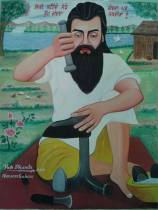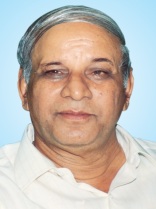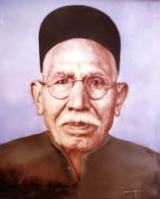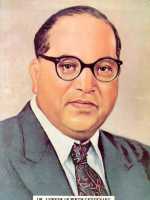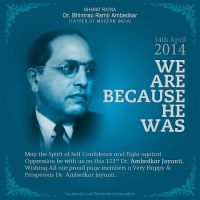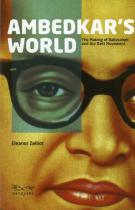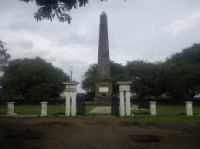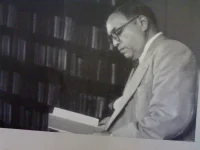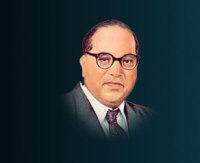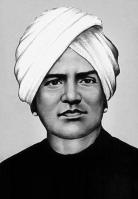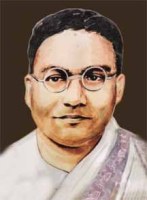Jagesh: The American Experience of Dr. B.R. Ambedkar
Very few of India’s leaders have been educated in America. In the British period, England and to a lesser extent France and Germany were the focal points for overseas study. Even today, when Indian students flock to America, their education is generally in the field of technology or science, and they do not enter politics. As far as I have been able to find out, only three men well known in public life have been thoroughly exposed to an American experience: Jay Prakash Narayan; the late Chief Minister of the Punjab, S. Pratap Singh Kairon; and Dr. B. R. Ambedkar. An American inevitably wonders what effect his country has had on the lives and thinking of these men.
It is clear that J. P. Narayan’ s direct contact with Amecican poverty during the Depression era and with American radical thinkers somewhat influenced the development of his socialist attitudes. It is possible that Kairon learned some of his expertise with mass politics from his interval in America. In the case of Dr. Ambedkar, the influence seems to be chiefly in developing his commitment to a pragmatic, flexible democratic system. Ambedkar spent the years from 1913 to 1916 at Columbia University in New York City. There is little material on his political thought from the pre-1913 period with which to compare his post-1916 writings, but even so I would like to suggest that the American experience did influence the thought and action of this unusually gifted and innovative son of Bharat.
B.R. Ambedkar entered the Graduate School of Columbia University in 1913 after graduating from Elphinstone College in Bombay. His patron was Sayajirao Gaikwad, Maharajah of Baroda. The Gaikwad was distinguished for his financial support of reform measures and had already assisted Ambedkar in securing his college education. Whose idea it was that Ambedkar should go to America is not clear. The Gaikwad was certainly amenable to sanctioning a stipend for Ambedkar’ s study in America through the Baroda state Education Department. However, Ambedkar was 23 at the time and he seems to have been intellectually mature, with his interests already established. From the time of Jotiba Phule, there has been a sense of appreciation among the leaders of the Non-Brahman Movement for America’ s effort to create an egalitarian democracy. Ambedkar was aware of this, and it is quite possible that he himself made the decision to go to America.
As a student at Columbia, Ambedkar explored as widely as possible the economic and social aspects of American development. He took an enormous number of courses ranging from the economics of American railways to American history, auditing what he could not take for credit. He seems to have exposed himself to as many of the top-ranking professors at Columbia as he could, whatever their field. Columbia at this time was in its Golden Age, and the list of men with whom Ambedkar studied represents a catalog of important early-20th-century American thinkers. John Dewey, James Shotwell, Edwin Seligman, James Harvey Robinson, Franklin Giddings, and Alexander Goldenweiser were all men of great importance in the development of American thought, and probably nowhere else could Ambedkar have received such a broad and deep exposure to an optimistic, expansive, pragmatic body of knowledge.
Interestingly enough, Ambedkar’ s own original research at Columbia was concerned with Indian themes. In his primary field of economics, under the guidance of Edwin Seligman, he wrote a dissertation for his Ph.D. on The Evolution of Provincial Finance in British India (published in 1925 by P.S. King and Company, London). His thesis was critical of the imperial British system and its harmful effect on Indian development. The other major publication coming out of the Columbia experience was a paper on “Castes in India, Their Mechanism, Genesis and Development, ” given first in a seminar in Anthropology with Alexander Goldenweiser and published in May, 1917, in The Indian Antiquary. Both studies make it clear that although Ambedkar was gaining all he could from his educational opportunity in America, his attention was centered on using that knowledge to analyse the Indian situation.
Ambedkar’ s paper on caste was not a diatribe against the iniquities of the caste system but rather an effort to present a theory of the development of the system. His two main points are significant. First, there was a basic, unified Indian culture. He wrote, “Ethnically all peoples are heterogeneous. It is the unity of culture that is the basis of homogeneity. Taking this for granted, I venture to say that there is no country that can rival the Indian peninsula with respect to the unity of its culture.” Second, he denied that caste stratification arose through racial, color-related, or occupational factors. He stated that the caste system grew through a process by which other groups imitated the endogamy of the Brahman priest caste. There is no development of a theory of untouchability in the paper; that was to come late in Ambedkar’ s life. These two premises, however, remained constant in his thought. His later theory of the development of untouchability and his work for the eradication of untouchability were based on these theories, i.e. that Indian culture was basically unified and basically valuable, and that caste inequalities were a social development without a racial origin.
It is difficult to say what effect the study of anthropology and sociology under Goldenweiser and others at Columbia had on Ambedkar. Certainly he felt such systematic study of society was valuable, for he instituted a Department of Sociology at Siddharth College in a day when Sociology was not usually offered in Indian colleges. Also, the sociological vocabulary lingered, and perhaps some of the concepts behind the American jargon. Shortly after returning from his study abroad, Ambedkar testifed to the Southborough Committee on Franchise, the group which was preparing the election procedure for the Montagu-Chelmsford Reforms instituted in 1921. Ambedkar’ s lengthy testimony before this body stressed the lack of “endosmosis&qu ot; or “like-mindedne ss” between Touchable and Untouchable – phrases evidently borrowed from American social analysis. Ambedkar’ s solution was to educate and politicize the disadvantaged group into full use of popular assemblies so that the new political institutions would not continue the “hardships and disabilities entailed by the social system.” Ambedkar may have observed the ethnic groups in New York, the Irish, Italians and Jews, gaining political power through unified political pressure. The early-20th-century American dream of social and political equality in the great melting pot was apparent in both academic circles and actual New York life during Ambedkar’ s time at Columbia University. Both Ambedkar’ s study and experience would have encouraged him to look beneath cultural differences for a basic national cultural unity and to look to the political process as the way in which different groups attained their proper place on the national scene.
A direct comparison between the Negroes of America and the Untouchables of India does not appear in Ambedkar’ s writings. This is natural, since Ambedkar denied that there was a racial basis for untouchability. In contrast to the leaders of almost all other Untouchable movements, he refused to claim that Untouchables were “Adi-Dravida, ” (the first Dravidians), or “Ad-Dharm, ” (the first religion, i.e. pre-Aryan), but stressed that they were of the same racial background as other Indians. His observation of the obvious racial differences between Negro and white Americans and the segregation based on race in America may have heightened his belief that the Untouchables&# 39; way to equality lay in asking for political and educational privilege because of social discrimination, not because of a separate racial background.
Ambedkar’ s understanding of the American situation was quite sophisticated. Jotiba Phule, as early as 1873, had dedicated his book Gulamgiri (slavery) to “the good people of the united States…for their sublime disinterested and self-sacrificing devotion in the cause of Negro Slavery.” But Ambedkar noted the political expediency of Lincoln’ s action in freeing the slaves. In his criticism of Mahatma Gandhi in What Congress and Gandhi Have Done to the Untouchables (2nd edition published by Thacker and Company in 1942), he compared Gandhi and Abraham Lincoln, stating that both were concerned with freeing the depressed groups in their countries for the political reason of preserving national unity. This view of Lincoln’ s Emancipation Proclamation now has currency among American Blacks, who no longer view the freeing of the slaves as “disinterested and self-sacrificing. ” Although Ambedkar did.not identify with the American Negro in words, he understood their position well enough to anticipate their criticism of Lincoln. Ambedkar’ s understanding of the reformer as politician was based on bitter experience, but it also reflects his grasp of comparative history. He did not borrow wholesale from the American experience, but he used his knowledge of American culture to analyze his own country’ s social situation.
Although the study of economics was Ambedkar’ s major interest in both the United States and in London, there was little scope for him to take action in his field in his public life in India. His stance was basically socialist, but he did not align himself with any socialist party except for specific election alliances. He admired a number of the economic measures taken by the Soviet Union to reform their economy, and at one time advocated state control of the land. But he also harshly criticized the political system of the Soviet Union, and he was not a Marxist. The theory that history was the result of economic forces held little meaning for him.
If Ambedkar had succeeded in becoming head of the Planning Commission (and it is probable that this was his wish), he might have developed some of his socialist ideas within the context of democracy. His chief economic measures, however, were limited to those taken while he was Member for Labour in the Viceroy’ s Executive Council in the years before Independence. While holding the Labour Portfolio, he instituted a Tripartite Labour Conference to consider such matters as a Joint Labour Management committee and an Employment Exchange, and he attempted to institute social security measures for industrial workers. In these matters, both American and British policies offered some guide lines.
It is in the basis of Ambedkar’ s politics that American influence seems strongest. Behind all of Ambedkar’ s seeming separatism – separate political parties for the backward classes, special reservation of seats in political assemblies and in government jobs – there was a strong, unwavering belief in the power of democratic institutions to bring about social equality. India’s case might demand special techniques not found in the West, but Ambedkar’ s basic faith was in representative political bodies. It is too much to say that Ambedkar’ s American experience created this belief, but it is clear that it strengthened it. John Dewey’s thought especially was meaningful to Ambedkar, for it offered encouragement that educated and politically aware peoples could work out their own political destiny in a pragmatic way, pruning the useless and preserving the useful in their societies. In his Annihilation of Caste Ambedkar quotes John Dewey, “who was my teacher, and to whom I owe so much”: “Every society gets encumbered with what is trivial, with dead wood from the past, and with what is positively perverse. As a society becomes more enlightened, it realizes that it is responsible not to conserve and transmit the whole of its existing achievements, but only such as make for a better future society.” Direct references are few, but as late as 1954, Ambedkar wrote to a Scheduled Caste student then in London, asking him to go to the British Museum and copy out Dewey’s book on democracy, then out of print, for use in an essay on democracy.
All his life Dr. Ambedkar worked to further the education of the deprived. Not only was his achievement in terms of numbers of institutions great, but those institutions were innovative in a way that John Dewey would have approved. Siddharth College, founded in Bombay, was a “morning college” which allowed poor students to go to classes before their daily work. And it stressed a student parliament, which allowed untold numbers of students to experience all the intricacies and methods of parlimentary democracy in a mock version of national politics. Dr. Ambedkar College at Aurangabad was founded in an area that had no educational institution at the higher level other than a teacher training college. It offered not only Liberal Arts, but also Law and Commerce in an area totally deprived of any such opportunity, and I have been told that Dr. Ambedkar’ s wish was to add a department of Fine Arts so that Marathwada would not only have educational opportunity but a chance to develop the aesthetics of the long-dead but rich creative past revealed in the marvellously carved caves of Ajanta and Elora.
Another life-long belief of Dr. Ambedkar’ s may have been reinforced by his contact with John Dewey and his observation of the American scene. Dr. Ambedkar held the most optimistic possible faith in the power of democracy. In spite of the difficulty of welding adherents who constituted a small minority into an effective political party, in spite of the flaws in the democratic process he must have observed on the American scene, he never seems to have even considered a Communist structure or any sort of authoritarian government a possible cure for India’s ills. His belief that people could be educated into change, that total participation of all elements of society in the political process was essential, that parliamentary democracy was the only conceivable way for India to progress, seems to have been unshakable. In my opinion, his constant support of the democratic system greater strengthened India’s commitment to this path.
There are other traces of American thought in Dr. Ambedkar’ s philosophy. One that seems to me to be exceptionally important is his position on India’s cultural and ethnic unity. His first writing on this appears in the paper he wrote for a year-long seminar in Anthropology with Columbia Professor Alexander Goldenweiser, that was later published in The Indian Antiquary for May, 1917, under the title “Castes in India, Their Mechanism, Genesis and Development. ” In this paper, as we noted above, he denied that color or occupation had determined caste; he was very clear that India had a remarkably deep cultural unity, and that caste divisions were not created by “the conscious command of a Supreme Authority,” but by “an unconscious growth in the life of a human society under peculiar circumstances. “
It should be remembered that in the 1920’s, when Dr. Ambedkar began his work, there were several movements among the Depressed Classes to separate themselves from “Aryans. ” A movement in the North was called Adi-Dharm (original religion), and one in the South was called “Adi-Dravida&q uot; (original Dravidians). Dr. Ambedkar’ s insistence on cultural unity overcame this thrust for separatism. He referred to religious ideas to support this idea, not to the works of Manu but to the idea of Brahman, the universal divine principle, which he felt should have produced the most egalitarian society on earth. Dr. Ambedkar carried this idea of cultural unity into action when he founded his schools, his reform organizations and his political parties – not a single one was ever limited to his own caste or bore his caste name, and only one was expressly for Scheduled Castes, and that for purely political purposes. From the beginning, anyone in need, anyone with concern, could be a participant. From the beginning, any special treatment was seen as temporary, as a way to raise the standards of the deprived group so that it could participate on an equal basis.
In this matter of cultural unity, it may be that America’ s influence was due to its own problems, its own separatism. Dr. Ambedkar must have observed the racial discrimination in America, and determined that India must avoid any such permanent separation. Here again, it seems to me that his stres on unity has contributed greatly to India’s ideal of cultural integration.
I have mentioned practicality and pragmatism, but I do not mean to imply by these terms that Dr. Ambedkar was a “practical politician.” He actually was far more statesman than politician, and I have felt at times that he could not pay enough attention to organization, to detail. As a statesman, however, his idealism, his vision, was mixed with a down-to-earth pragmatism that is the mark of any successful movement. As an example, he put aside some of his visionary ideas (government ownership of land, for instance) in order to help India create a viable, widely accepted Constitution. Anyone who reads his “draft constitution” written in the late 1940’s, and then traces his leadership of the process of writing a constitution and notes the final result, will be struck by the difference in what he first thought was right and what he finally approved as India’s need at that time. I have talked to Scheduled Caste leaders who felt Dr. Ambedkar was too much of a statesman, not enough of a politician. My own feeling is that leadership of his calibre is still needed, that his combination of vision and pragmatism will influence India’s direction long after the current generation has left the scene.
When I look at the new thrusts of India’s Scheduled Castes – the commitment of many to an ethical and inclusive Buddhism; the urge to write poetry and fiction and drama that communicates on a high literary plane to all men; the efforts, however ineffective they may seem at this time; to play a real role in politics; this effort of those who live in America to show commitment and concern for their homeland – and when I see how much of this pride and hope and dynamic can be traced back to Babasaheb Ambedkar, I am proud to honor the memory of a very great man.











